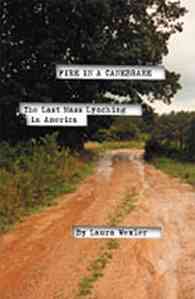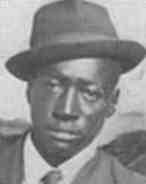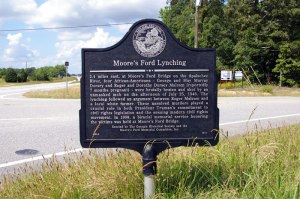Fire in A Canebrake: The Last Mass Lynching in America[1] by Laura Wexler described the July 25, 1946 lynching of four African Americans near Moore’s Ford Bridge in Walton County, Georgia. This book also talked about the political and racial climate of time, the FBI investigation, FDR’s early attempts at giving the federal government more authority in civil rights cases, and Truman’s attempt at strengthening civil rights legislation and desegregating the army in response to these killings. Finally, Wexler showed how these events are “interpreted, believed, told, and remembered.”[2]
Wexler does an excellent job at proving her thesis that racism obscures the truth, which, in turn, makes justice and healing impossible. She said blacks and whites had disagreements regarding the Moore’s Ford Lynching just like they do not agree about the truth in more current cases like the O.J. Simpson or Rodney King trials. For instance, there are differing accounts as to what Roger Malcom said after he stabbed Barnette Hester. Barnette’s family said Roger said “Call me Mr. Malcolm from now own” but Roger Malcom’s mother claimed Roger said something about Barnette Hester having sex with his wife, Dorothy Dorsey[3] Wexler said that racial issues like this can best be viewed as a void where the truth should be.[4] Wexler disagreed with some white Georgians who said it is best not to bring this lynching up because it will just lead to more racial divisions. In contrast the author states,
“The only way for blacks and whites to live together peacefully in America in the twenty-first century is if we begin struggling to understand and acknowledge the extent to which racism has destroyed-and continues to destroy-our ability to tell a common truth.”[5]
This is a complex and subtle thesis that touches on both the themes of memory and justice. Wexler displays that what people remember and the significance they place on that memory is very different between blacks and whites. After the lynching whites did not want to bring it up again because they were afraid of being seen as a racist, they did not want to stir things up, or they just want to forget about it because they have other more pressing concerns. For instance, a Monroe insurance salesman said most people could “careless” about this incident and he had “other issues that I’m trying to work on…to try to help Monroe and Walton County be a better place to live.”[6] Other whites were affected by their personal relationship to the case. For instance, Loy Harrison’s grandson said Loy did not commit any crime and added Loy was his “hero.”[7]
Blacks and some whites, on the other hand, needed to bring this up to look for justice and healing. For instance, Bozie Daniels said if a person cannot tell truth then you are a slave in your own country.[8] Another example was the Moore’s Ford Foundation (MFF), established in 1991, which put on reenactments of the lynching and erected an historic plaque to keep memory of this tragedy alive. They thought this would lead to healing in the community. They expressed this motivation by placing the following quote on George and Dorothy Dorsey’s gravestone, “May your’ suffering be redeemed by brotherly love”[9]Wexler shows that people’s motives can sometimes cause them to remember things inaccurately. For instance, the MFF had a public ceremony to honor the victims of this lynching in the 1990’s. Moena Williams, the mother of 2 of the victims, never went to their original funeral so the MFF brought her to this public ceremony to try to bring some closure to the community. However, they made a mistake because Moena Williams had actually died several years before.[10] In addition, many white people mistakenly remembered that Barnette Hester was killed by Roger Malcom when he was not because that fit with their racist attitudes.[11]
Fire in A Canebrake also showed how the differing interpretations of the same events by whites and blacks led to injustices. Wexler talked about the Primus King Case and the Smith vs. Allwright court cases. These cases both ruled that blacks could vote in primaries even though the Georgia Democratic Primary had been white only since the end of Reconstruction.[12] Whites liked Eugene Talmadge called this a second Reconstruction and blacks called this a second emancipation. This showed that whites thought of this law as the Federal Government impeding in local politics to allow incompetent blacks to vote, just like Reconstruction. This gave them the motivation to commit many injustices against blacks such as having voter intimidation, questioning valid black voter registration, using the County Unit System that went against the popular vote and favored the rural White Farmers.[13]
The different attitudes of whites and blacks toward the Moore’s Ford Lynching also led to injustices against African Americans. Blacks and the national news called this lynching a symbol of hypocrisy between the promise of American democracy and real lives of black people in the South. For example, the NBC nightly radio broadcast said this lynching was a disgrace to the USA.[14] However, local whites thought of this an entertainment and not that serious. For instance, whites went to the scene of the crime to collect lynching souvenirs in order to make good luck charms.[15] This cavalier attitude led whites to commit injustices towards the black victims by tampering with evidence because they did not even think the suspects would ever go to trial. When the FBI did conduct an investigation, the whites put up a wall of silence because they saw the FBI agents as outsiders from the North even though most were from Southern states. [16] Wexler ends the book with some by talking about a person named Linda Lemons, who was old enough to remember the lynchings. She said that the people who did this did not know what they were doing was wrong, but now she does know it was wrong.[17]
The author also shows how all of these injustices were enabled by the lack of a reliable, equitable, effective, powerful government to enforce civil rights laws. Some progress was being made in the area of civil rights. For example, FDR created the Civil Rights Section of Justice Department and issued directives to convict people on civil rights abuses.[18] However, civil rights abuses in the case of lynchings were hard to prove because murder was a state not federal crime. So defense attorneys, as in the Screws Case, only had to argue that the white person killed the black person out of a personal vengeance and not to violate his Civil Rights to avoid federal involvement.[19] This was important because it affected how the FBI investigated the Moore’s Ford Case. The agents tried to tie the police officers to the conspiracy instead of just trying to investigate who lynched these four individuals. The lack of government effectiveness can also be seen in the lack of protection for blacks when they were voting in the Democratic Primary for the first time since Reconstruction. Bozie Daniels said black people had not motivation to vote because landlords had the power not politicians.[20] It is also interesting that Dorothy Dorsey went to Loy Harrison and not the Sherriff to help protect Roger Malcom from mob violence.[21] This, again, proved the landlords had more power to protect blacks than government officials.
Fire in A Canebrake had many strong points and some weaknesses. The most compelling aspect of the book was Wexler’s portrayal of the lynching itself. The book read almost as a fiction novel instead of a history book. It had vivid detail and drama that is not normally seen in academic history books. Wexler did a good job of explaining the events as a journalist would do but she also explained the racial context as an historian would do. For instance, Wexler explained that Loy Harrison bailed George Dorsey out of prison. However, she goes beyond that to say that Loy Harrison was forced to take blacks out of prison because many blacks were moving North after World War II, which caused a labor shortage and increased labor costs.[22]
Wexler also makes excellent use of the available sources and does not make up scenes without having the proper documentation. This is impressive considering how other authors like James Goodman, tend to go beyond their sources when writing narrative history. Wexler used FBI reports, newspaper accounts, and the papers of Harry Truman and the NAACP, as well as oral history interviews she conducted herself. Wexler is careful to always attribute her source when talking about the events of the lynching. She never writes as an all knowing narrator but, instead, shows that this information is obtained from somebody with their own perspectives and bias. Her excellent use of sources also prevents her from the pitfalls of presentism that she could have fallen into since she talked about current cases like the OJ Simpson trial. This could have damaged her interpretation by imposing the present context on the past. However, she avoids this by sticking to the sources. She also justifies some presentism by saying that the Moore’s Ford Lynching is still relevant since it has not been solved and people still remember it in vastly different ways.
The book had some logistical weak points. For instance, there was no index, footnote markers, or table of contents. This showed this book was for a more general not purely academic audience. This makes the book more popular but was frustrating when trying to analyze this book for its historical merit. The thesis was also buried in the author’s note at the end of the book. The authors note would have been better suited to be the first chapter to tell the reader the general themes that are contained in the book. The book also tried to do too much in relatively short amount of space. The best example of this is the overwhelming number of people mentioned in the book. Wexler did a good job of explaining the background to some people but after a while the amount of people became confusing. Even so, this shows that real life is complicated and it involves many people. This is a good warning to other history books that try to make broad thesis statements that cover a wide historical period because Wexler’s book shows that real life is rarely as simple as a general thesis statement.
The book made great use of one map, one picture, and one poster at the beginning of the book stating that there was a reward for the capture of the lynchers. However, much more could have been done. Including pictures of more people would have helped the reader keep track of everybody. Wexler also talks about individual streets of Monroe, GA so a more detailed map of this city would have also been helpful.
[1] Laura Wexler, Fire in A Canebrake: The Last Mass Lynching in America (New York: Scribner, 2004).
[2] Wexler, 265-267.
[3] Wexler 1-7.
[4] Wexler, 1-7.
[5] Wexler, 267.
[6] Wexler, 222.
[7] Wexler, 221
[8] Wexler, 184.
[9] Wexler, 231.
[10] Wexler, 225-230.
[11] Wexler, 243.
[12] Wexler, 26-27.
[13] Wexler, 26-27.
[14] Wexler, 81.
[15] Wexler, 73-75.
[16] Wexler, 115-133.
[17] Wexler, 244.
[18] Wexler, 153.
[19] Wexler, 109.
[20] Wexler, 33-44.
[21] Wexler, 17-18.
[22] Wexler, 18-28.


![Loy Harrison [right] with FBI agent](https://matthewtkeough.files.wordpress.com/2013/03/loy.jpg?w=240&h=182)



